On-field simulation helps sports medicine teams perform at peak
Under the scorching summer sun, USF athletic trainer Yuriy Chulskiy huddled over a human simulator lying on the Astroturf at the USF football practice field.
Listening for breath sounds and watching for movement, Chulskiy studied each nuance of iStan, an advanced patient simulator, in an exercise designed to help recreate medical emergencies like cardiac arrest and spinal injuries that could occur during athletic competitions.
“Whenever it does happen in real life, we’re dealing with peoples’ lives and that’s serious,” Chulskiy said. “You want to be confident when you face the real thing – you want to be able to perform.”

The interdisciplinary team responds to a cardiac arrest simulation.
iStan can breathe, speak, and has a heartbeat – providing USF Health faculty and staff from the Sports Medicine and Orthopaedic Department, USF Athletics, and the SMART (Sports Medicine & Athletic Related Trauma) Institute a chance to practice responding to what they could potentially find on the field.
“We expect our athletes to practice in order to perform at their best, shouldn’t we expect our medical professionals to also practice to perform at their best?” said Micki Cuppett, EdD, ATC, associate professor and director of the Athletic Training Education Program at USF Health.

Cuppett, who organized the on-field simulation session, invited staff from University of Tampa, St. Leo University, Tampa Bay Buccaneers and Tampa Fire Rescue. It was an opportunity for different types of healthcare practitioners to work together as interdisciplinary teams, much like they would in real life at Tampa’s Raymond James Stadium, where USF football games are held, or other sports venues.
The physicians, athletic trainers and paramedics practiced more than the clinical skills involved in providing life-saving measures to critically injured athletes. During post-simulation debriefings, participants identified gaps in communication and areas for improvement in handoffs in care and cooperation as a team.


Orthopaedic surgeon Chuck Nofsinger, MD, assistant professor in the Department of Orthopaedics and Sports Medicine, usually sees players after their initial injuries on the field. This drill helps him prepare for his role, should he be on the sidelines as a team physician when a player goes down.
“Imagine being in a stadium where everyone’s adrenaline is at maximum,” Dr. Nofsinger said. “You want to turn everyone’s behavior into a script so they know their role inside that script when that happens. That’s why this simulation is so important.”
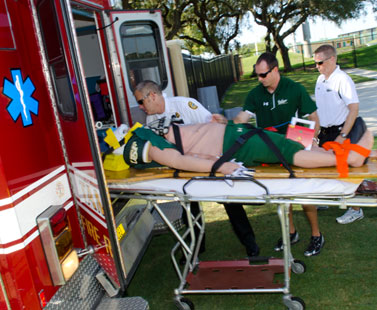
Cuppett will present the results of the simulation in November at Collaborating Across Borders III International, a joint Canada-U.S. conference focusing on interprofessional education and practice. More photos below.
Video by Amy Mariani, story by Susanna Martinez Tarokh, and photos by Eric Younghans
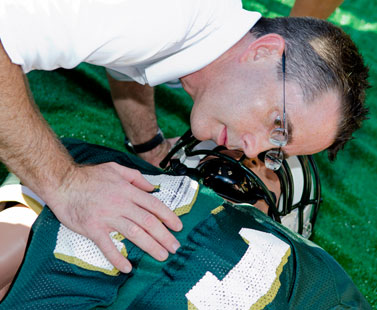
USF Health orthopaedic surgeon Dr. Charles Nofsinger listens for
breath sounds during one of the simulation exercises.

Dr. Eric Coris, director of primary care sports medicine at USF Health,
checks for a pulse.
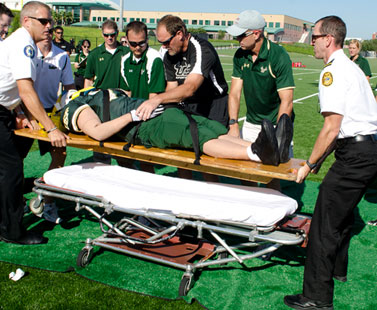
Dr. David Leffers (center), chair of Orthopaedics & Sport Medicine, works with athletic trainers and paramedics to help prepare the “injured athlete” for transport.
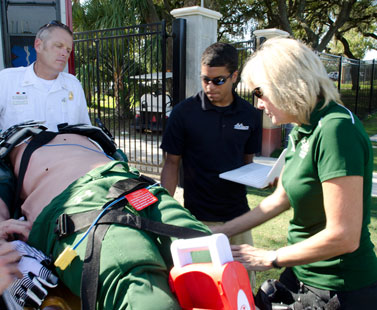
Micki Cuppett, director of USF Health’s Athletic Training Education Program, coordinated the on-field simulation exercises. Here, she resets iStan’s computer for another scenario.
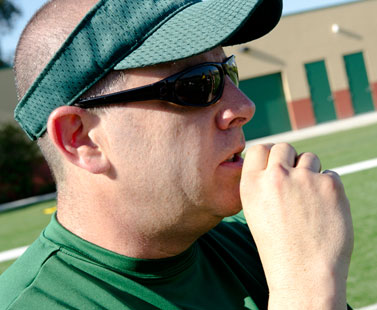
SMART Institute Executive Director Jeff Konin was the voice of iStan.
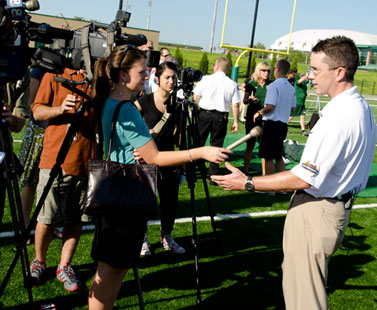
The simulation attracted local media attention. Dr. Nofsinger
is interviewed during a break in the action.
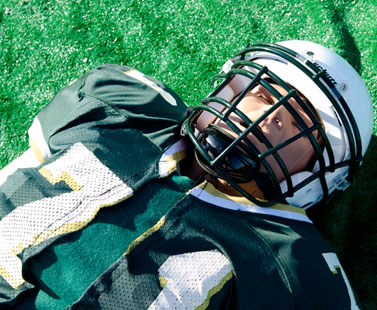
iStan will “live” for yet another drill.

